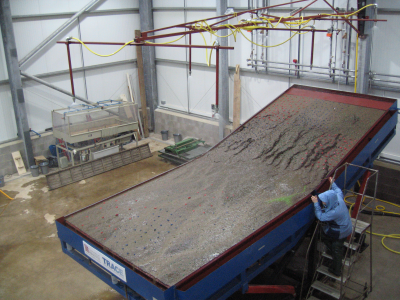TRACE
 TRACE (Test Rig for Advancing Connectivity Experiments) is a new experimental facility comprised of a state-of-the-art, large-scale artificial hillslope and accompanying rainfall simulator.
TRACE (Test Rig for Advancing Connectivity Experiments) is a new experimental facility comprised of a state-of-the-art, large-scale artificial hillslope and accompanying rainfall simulator.
The artificial hillslope is a dual-axis soil slope measuring 6m long × 2.5m wide × 0.3m deep with a folding action about the centre line of the larger dimension. The rainfall simulator is a nozzle type and can produce rainfall intensities up to 150 mm h-1. The folding about the centre of the slope enables the setting-up of different topographies representing, for example, the interface between hillslope and floodplain or complex topographies (i.e. abrupt breaks in slope, convex or concave slopes). The gradients of the two halves of the soil slope are independently tiltable in the vertical dimension: the top half from 0o to +15o and the bottom half from -15o to +15o. The entire slope also tilts along the horizontal dimension from 0o to 5o. Overland flow at the top of the slope can be applied by means of an overflow trough. Below the 0.3 m soil zone there is a sub-base layer that is 2.5 m3 in volume that represents the groundwater zone. At the base of the slope there are multiple spatially-distributed outlets that allow sampling of percolated water from different parts of the slope. They also allow for injection of water with a distinct signature into the 'groundwater' zone.
This facility has been funded by the University of Bristol for the furthering of hydrologic and geomorphic science through the development of innovative measurement technologies in hillslope processes. TRACE is one of few facilities of its kind internationally.
TRACE can be used to study hydrological, biological, chemical and sediment-transport processes on hillslopes and on hillslope-floodplain interfaces.
An experiment:
A 'storyboard' of a typical experiment [PDF format]
Contact:
Dr Katerina Michaelides - TRACE Manager
email: katerina.michaelides@bristol.ac.uk
tel: +44 (0)117 954 6857
